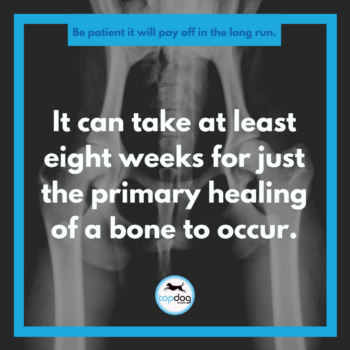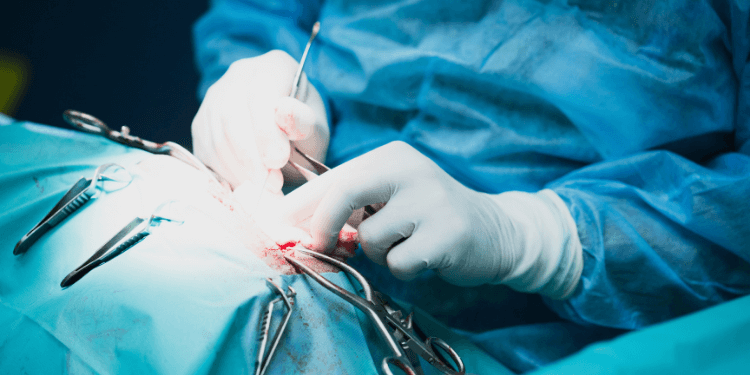Dog orthopedic surgery can help with a wide scope of issues, restoring optimum mobility, health, and quality of life to your pet. But like any type of surgical procedure, it does come with possible complications.
Potential complications can be categorized into three main areas:
- Complications during surgery
- Early post-surgical complications – typically occurring within two weeks of surgery
- Late post-surgical complications – which can occur months or even years later
In addition to becoming aware of the possible complications during each phase, it’s equally important to know how to reduce the likelihood of those complications to help ensure your dog heals as happily and rapidly as possible.

Possible Complications During Dog Orthopedic Surgery
No matter how common or routine a surgical procedure may be, they always come with potential risks. In the case of dog orthopedic surgery, those complications may be associated with:
- Anesthesia
- Bleeding
- Focal tissue trauma
- Nerve trauma
Complications from anesthesia can occur at any time, starting with the administering of the anesthesia and up to 24 hours following the procedure. Close monitoring is vital during this timeframe.
Most of the complications are mild and can be remedied quickly, consisting of things like decreases in blood pressure, respiratory rate, or body temperature. More serious complications, including death, are likewise possible but not common.
Bleeding, too much, during surgery is another possible complication. However, skilled veterinary surgeons are aware of and prepared for such an event.
Focal tissue trauma refers to tissue injury in a localized area, typically in the region where the surgery is being performed.
While nerve damage is one more possibility, nerves are fragile and may be injured by stretching, cutting, or pressure. It is important to remember that the type of procedure and exact region of the body will influence the likelihood of certain complications.

Early Post-Surgical Complications
Early post-surgical complications refer to those that occur within two weeks of the procedure. Most of the risks during this phase are related to the incision. They include:
- Infection
- Fluid accumulation
- Separation of the incision or failure to heal
More serious early post-surgical complications are less common; they include:
- Post-operative bleeding
- Implant failure or fracture
One of the most common risks during this time is a post-operative infection, which often occurs when the dog repeatedly licks the wound. It’s a normal reaction for dogs to lick their wounds, so outfitting him with a cone is a must to keep the area clean.
- More information on helping your dog accept their cone can be found here.
- More information on your dog sleeping with their cone can be found here.
Signs of infection can include swelling, redness, oozing, or notable heat or pain when touched. Warm compresses may help alleviate the infection, however, you should always consult your vet before applying anything moist to a wound. Antibiotic ointments are not generally advised unless specifically instructed by your veterinarian.
- More information on helping your dog’s surgical wound heal faster can be found here.
Two other incision-related risks are officially known as seroma formation and dehiscence. Seroma formation is an accumulation of fluid that builds up under the skin’s surface. Dehiscence refers to the opening of the wound or its failure to heal.
Smaller seromas often disappear on their own, although larger ones may require veterinary attention. The same holds true for wounds that open or fail to heal as well as infections that don’t subside.
- More information about bumps on your dog’s surgical incision can be found here.
You’ll also want to take a trip to the vet if your dog’s wound continues to bleed or if he shows signs of early implant failure or fracture. Neither should be happening during dog ACL surgery recovery or recovery from other orthopedic procedures. Signs can include acute pain, discomfort, and limping.

Late Post-Surgical Complications
Late post-surgical complications can occur after several weeks, months, or even years following the procedure. They include:
- Delayed healing
- Implant complications
- Late surgical site infections
- Re-injury
- Arthritis
- Cancer
While many dog orthopedic surgery cases may result in proper healing and optimum health moving forward, there is a potential risk of complications down the line. Dogs may experience delayed healing of the wound or surgical site.
Implant complications can result in a rejection of the implant, with the body treating it as a foreign body. Late surgical site infections can include osteomyelitis, which is an infection within the bone. Bone infections can begin within the bone itself or travel to the bone through nearby tissues or the bloodstream.
Dogs that get back into activities too soon after surgery run a higher risk of re-injury. They may cause additional harm to the initial injury, or even experience new injuries. Between 30% to 50% of dogs with a torn cranial cruciate ligament (CCL) will end up tearing their other CCL.
The CCL is equivalent to the human ACL, and dog ACL surgery recovery can take quite some time. When surgeries involve cutting a bone, it can take at least eight weeks for just the primary healing of a bone to occur. However, following the proper physical therapy after orthopedic surgery can reduce your dog’s chances of re-injury and delayed healing.
- Learn more about post orthopedic surgery rehab guides here.
Arthritis is another risk following dog orthopedic surgery, specifically osteoarthritis. While it is almost certain your dog will develop some form of arthritis. You can control how quickly and how severely it comes on. By adding a comprehensive joint supplement and natural anti-inflammatory to your dog’s diet, you can slow the progression and severity of arthritis.
- Learn more about what ingredients to look for in canine joint supplements here.
While rare, cancer has also been linked to orthopedic procedures that use metal implants in dogs as well as humans.

How to Minimize Dog Orthopedic Surgery Complications
Although possible complications may always exist with surgery, you can take steps to reduce your dog’s risk. The foremost is to select an experienced veterinary surgeon that has a proven track record with the procedure your dog needs and to follow up with consistent at-home rehab
Additional steps include:
Maintaining an ideal body weight.
Not only does excess weight place unnecessary strain on your dog’s joints, but it can also release hormones that cause body-wide inflammation. Increased inflammation, in turn, increases the progression of arthritis.
- You can learn more about dog weight loss here.
Adding quality supplements to your dog’s diet.
Quality supplements, such as those available at TopDog Health & Rehabilitation, have been shown to be extremely beneficial to joint health. They can significantly decrease inflammation, thereby reducing pain, arthritis progression, and damage to joint structures.
Avoiding extremely high-impact activities.
Playing with Frisbees, balls and excessive jumping can increase the risk of complications by repeatedly stressing out your dog’s joints.
Engaging in beneficial exercises.
Strengthen and maintain your dog’s muscles, ligaments, tendons, and joint flexibility with therapeutic exercises. Also, make sure your dog warms up and cools down before and after intense exercise sessions.
- You can read more about exercising with your dog here.
With an experienced veterinary surgeon, proper precautions, attentive aftercare, physical therapy, and beneficial supplements, you can reduce the risk of dog orthopedic surgery complications substantially. While there is always a chance of unforeseen events or happenings, you’ll be looking after the things you can control to enhance your dog’s health, happiness, and quality of life for the long haul.




 Flexerna Omega
Flexerna Omega 







